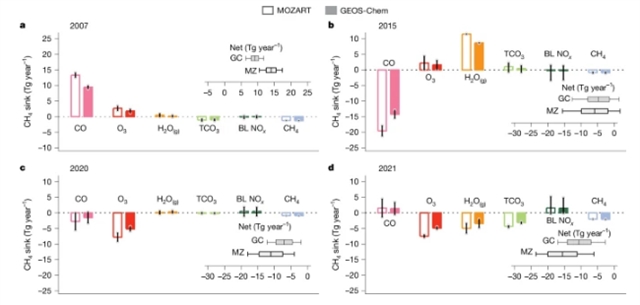
清华大学深圳国际研究生院郑博团队近日揭示了空气污染调节了全球甲烷收支的趋势和变异性。2025年5月28日出版的《自然》杂志发表了这项成果。
空气污染通过各种复杂的相互作用影响气候。它扰乱了地球的辐射能量平衡,改变了大气氧化能力,而大气氧化能力决定了甲烷等短期气候因子的寿命。这种动态的一个关键机制是空气污染物对羟基自由基(OH)的影响,羟基自由基是对流层中最重要的氧化剂,约占甲烷化学汇的90%。然而,对空气污染物、OH和甲烷在十年时间尺度上的相互作用的全面量化仍然不完整。
研究组开发了一种综合的观测驱动和模型驱动方法,以量化关键空气污染物的变化如何影响甲烷化学汇并改变甲烷预算。该研究结果表明,从2005年到2021年,对流层臭氧增强、水蒸气增加和一氧化碳水平降低共同导致1.3-2.0 Tg 全球甲烷汇每年增加1年,从而缓冲大气甲烷增长率。
甲烷汇的增加主要集中在热带地区,并表现出南北不对称。甲烷高增长时期通常与大气污染物波动导致的OH水平突然下降有关,尤其是在特大野火和疫情大流行等极端事件期间。该研究表明,在O3污染控制和OH介导的甲烷去除之间存在权衡,并强调了大范围野火增加一氧化碳排放的风险。
附:英文原文
Title: Air pollution modulates trends and variability of the global methane budget
Author: Zhao, Yuanhong, Zheng, Bo, Saunois, Marielle, Ciais, Philippe, Hegglin, Michaela I., Lu, Shengmin, Li, Yifan, Bousquet, Philippe
Issue&Volume: 2025-05-28
Abstract: Air pollution affects climate through various complex interactions1. It perturbs the Earth’s radiative energy balance and alters the atmospheric oxidation capacity, which determines the lifetimes of short-lived climate forcers, such as methane1. A key mechanism in this dynamic is the impact of air pollutants on the hydroxyl radical (OH), the most important oxidant in the troposphere, which accounts for approximately 90% of the methane chemical sink2. However, a comprehensive quantification of the interactions between air pollutants, OH and methane over decadal timescales remains incomplete2. Here we develop an integrated observation-driven and model-driven approach to quantify how variations in key air pollutants influence the methane chemical sink and alter the methane budget. Our results indicate that, from 2005 to 2021, enhanced tropospheric ozone, increased water vapour and decreased carbon monoxide levels collectively contributed to a 1.3–2.0Tgyear1 increase per year in the global methane sink, thereby buffering atmospheric methane growth rates. This increase in the methane sink was primarily concentrated in tropical regions and exhibited a north–south asymmetry. Periods of high methane growth were typically linked to abrupt OH level declines driven by fluctuations in air pollutants, especially during extreme events such as mega wildfires and the COVID-19 pandemic. Our study suggests a trade-off between O3 pollution control and methane removal mediated by OH and highlights the risk of increasing carbon monoxide emissions from widespread wildfires.
DOI: 10.1038/s41586-025-09004-z
Source: https://www.nature.com/articles/s41586-025-09004-z
Nature:《自然》,创刊于1869年。隶属于施普林格·自然出版集团,最新IF:69.504
官方网址:http://www.nature.com/
投稿链接:http://www.nature.com/authors/submit_manuscript.html
